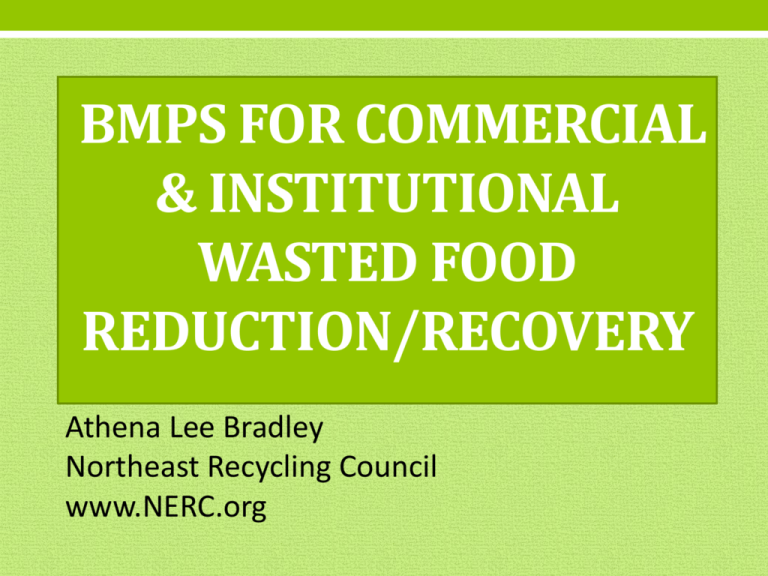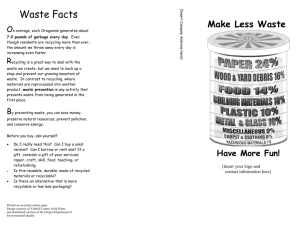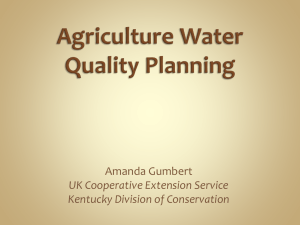Wasted Food Reduction BMPs
advertisement

BMPS FOR COMMERCIAL & INSTITUTIONAL WASTED FOOD REDUCTION/RECOVERY Athena Lee Bradley Northeast Recycling Council www.NERC.org Percent Wasted Restaurants • Percent of total purchased food • 11.3% Full Service / 9.55% Fast-Food • Percent of trash • 66% Full Service / 52% Fast-food Retailers - Percent of wasted food • Fresh fruit - 1.4%, fresh vegetables - 9.7%, fresh meat, poultry, & seafood - 4.5% Percent Donated or Recycled Restaurants • Donated, 1.4% (surveys vary 20-70%) • Recycled, 14.3% • Of this, more than 70% is cooking oil recycling Manufacturing • Donated or recycled 94.9% • More than 85 percent is repurposed for animal feed Retail/wholesale • Donated or recycled 42.4% • Composting & donation Benefits • Save $ - reduced commodities, labor, energy, disposal costs • Improved worksite sanitation • Recognition • Access to tax credits • Community engagement/social benefits • Environmental Wasted Food—Restaurants, Cafeterias Back of the house/pre-consumer • Expiration/spoilage, trim waste, incorrectly prepared food/overcooked, dropped, overproduction • Service stations – salad bars, self-serve, deli stations, misordered product, expired grab & go • Leftover catering Front of house/customer/post-consumer • Plate waste Wasted Food—Retailers • From transport - bruising, spoiling, drying • On shelf - piling, touching, dropping • No longer fresh “looking”/ “ugly” • Customers shop based on food appearance • Sell-by & best-by dates confuse retailers & shoppers Getting Generators on Board • Assist with waste audits/assessments • Provide training & resources • Promote the organics hierarchy • How to “right size” trash collection • Know donation & composting options • Grant money • Recognition Waste Audit/Assessment • Understand food service practices & how they generate inefficiency/waste • Determine baseline • Look at each point of generation • Pre-Consumer • Receiving, prep, production • Service: hot line, deli, salad bar • Post-Consumer Key Steps • Engage key stakeholders – “SWAT” • Review data, set waste minimization goals • Revise procedures, policies, menus • Daily overview/discussion; weekly meetings • Track/control systems • Ongoing measure of pre-consumer waste • Periodic review of plate waste – portion sizes Staff Training • Employee orientation • Ongoing • Staff meetings – solve issues as a team • Monitor staff compliance • Friendly competitions • Recognition/rewards • Consistent messaging, signage • Seek Feedback/Provide Feedback • Give periodic updates-$saved, food scraps diverted Wasted Food Reduction BMPs • Make wise purchasing decisions • Reduce inventory size, order more frequently • Practice proper storage/rotation • Invest in high-quality preparation & processing equipment • Specialized knives • Bulk food purchasing & dispensers BMPs, cont. • Batch Cooking • Consider secondary uses for excess food • Soups, salads, daily specials • Change the dishware • Smaller plates & glasses will reduce portions • Set smaller plates with food on larger plates to make portions look bigger BMPs, cont. • Monitor plate waste - adjust menu & portions • Allow employees to take home leftovers • Go trayless - students waste 25-30% less food without tray option • “Waste Awareness Drives” Retail Specific BMPs • Properly maintain perishable foods & groceries displays • Rotate older products in front of newer ones • Discount food that isn’t at peak freshness or “ugly” produce • Use in prepared deli foods, soups, etc. Food Recovery • Bill Emerson Good Samaritan Food Donation Act • Richard Russell National School Lunch Act • Amended to clarify that schools who donated food to charity are protected by Good Samaritan Laws • USDA & EPA recognize schools • K12FoodRescue.com - "Getting Started" Barriers to Donating Food • Transportation constraints • Insufficient storage/refrigeration on site • Liability concerns • Regulatory constraints • Insufficient storage/refrigeration at food banks • Confusion over use by/sell by dates Food Recovery BMPs • Know characteristics of suitable food – • Types of acceptable food • Food safety is key - trained staff, temperature control, timing, sanitation • Develop directory of food recovery organizations • Promote benefits—tax credits, liability protection, community benefits Food Recovery BMPs, cont. • Partnership building • Effective communication & relationships • Assist food recovery organizations in setting up route densities • Or, alternative means of transportation • Recordkeeping • Promote/Recognize participants Food Recovery in Action Farm Gleaning Food for Animals Grow Compost Vermont Grow Compost Vermont, cont. Recognition Universal Signs & Symbols Consistent Images Consistent Colors NERC Can Help We’re experts in Waste reduction & recycling Recycling program design & implementation Organics management Green procurement C&D reuse & recycling Electronics recycling School reuse, recycling & composting Textile recycling programs Multi-stakeholder dialogues & negotiations & More! Fee for service makes NERC’s expertise available at a reasonable price with outstanding results Athena Lee Bradley athena@nerc.org 802.254.3636 www.nerc.org








![School [recycling, compost, or waste reduction] case study](http://s3.studylib.net/store/data/005898792_1-08f8f34cac7a57869e865e0c3646f10a-300x300.png)